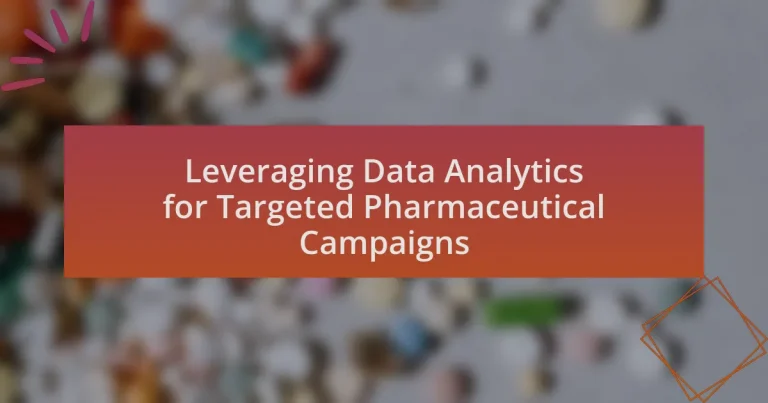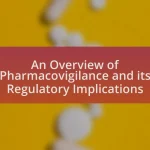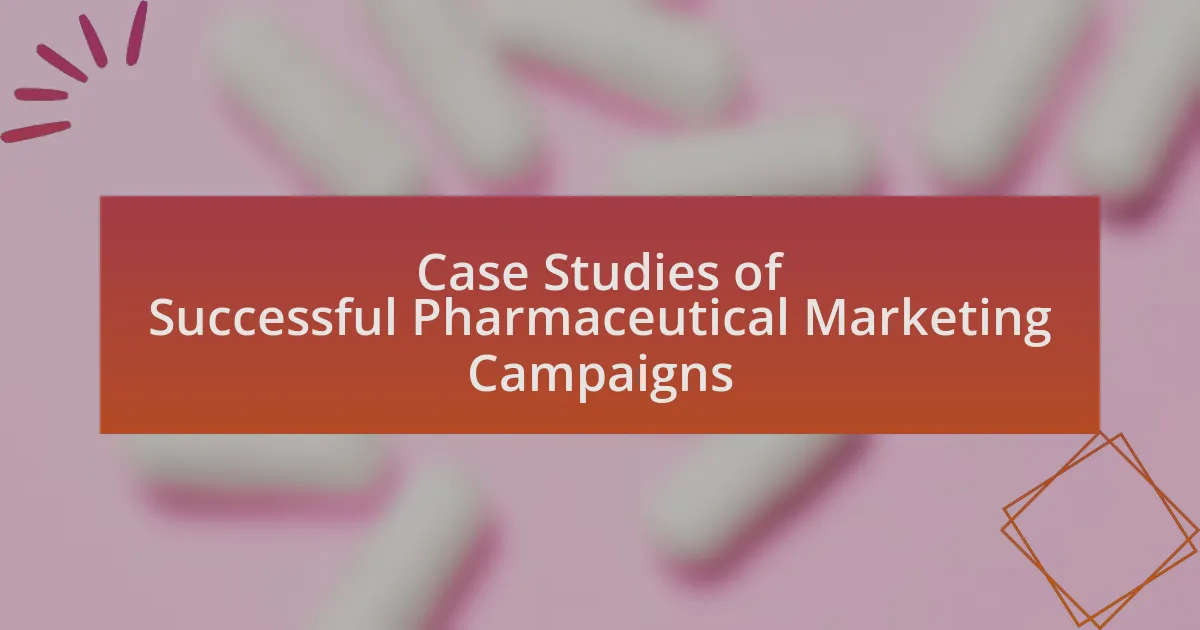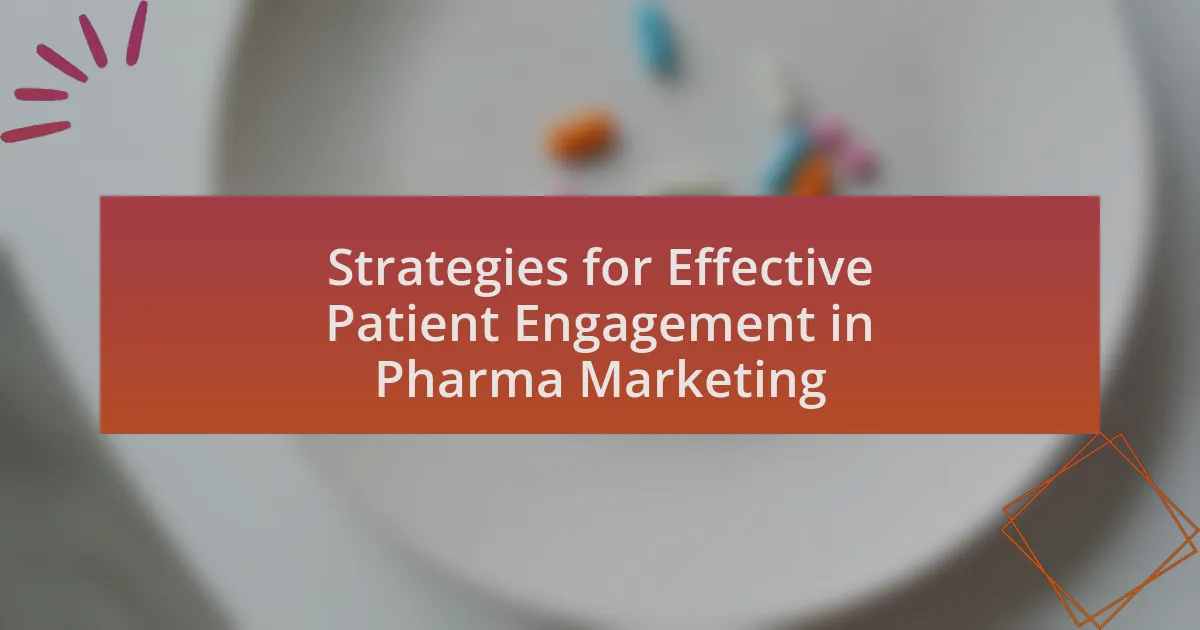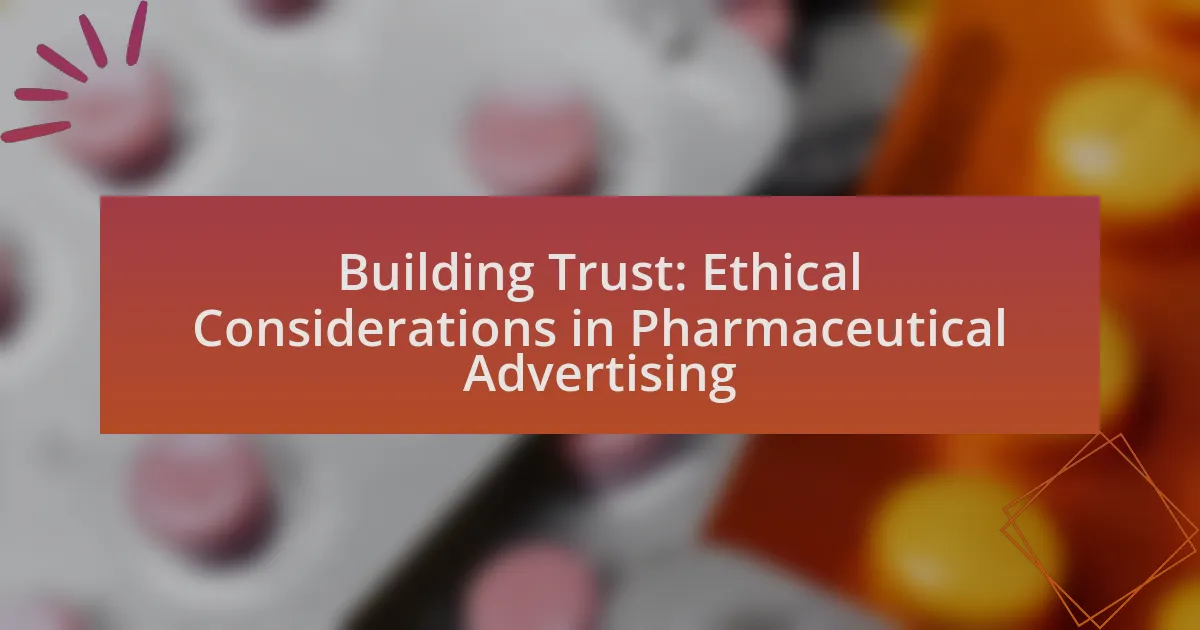Leveraging data analytics for targeted pharmaceutical campaigns involves using data-driven insights to customize marketing strategies for specific patient populations and healthcare providers. This approach enhances campaign effectiveness by identifying key demographics and behaviors, leading to improved engagement rates and optimized messaging. The article explores how data analytics enhances pharmaceutical marketing strategies, the types of valuable data utilized, the importance of targeted marketing, and the tools and technologies that support these efforts. Additionally, it addresses the role of machine learning, best practices for implementation, and common challenges faced by pharmaceutical companies in leveraging data analytics effectively.
What is Leveraging Data Analytics for Targeted Pharmaceutical Campaigns?
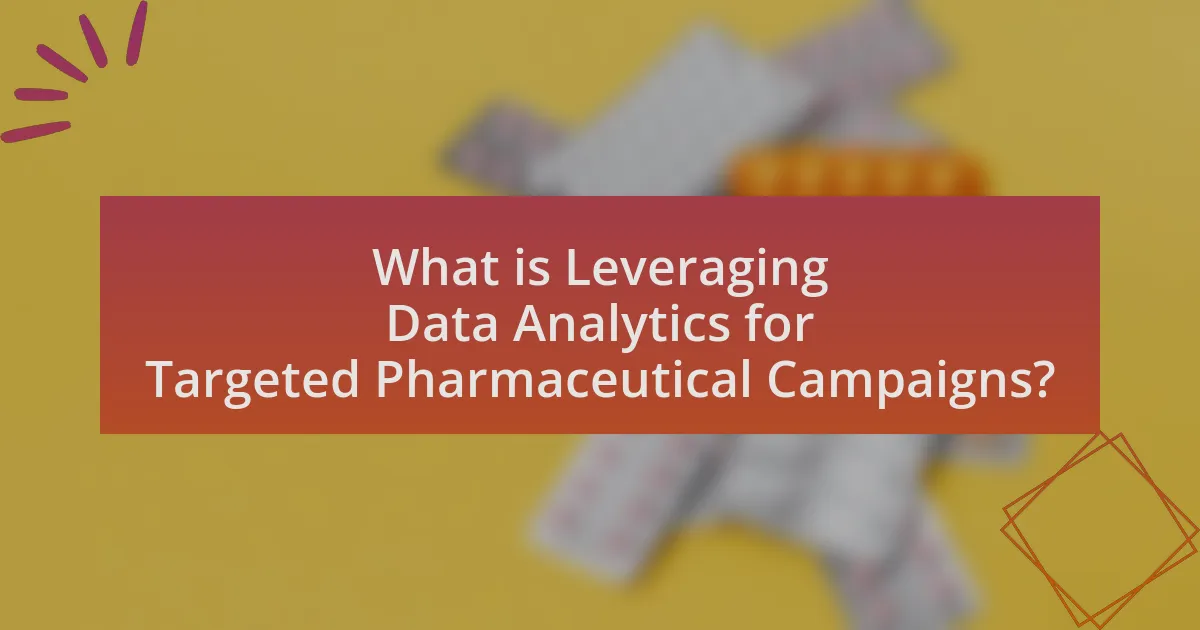
Leveraging data analytics for targeted pharmaceutical campaigns involves utilizing data-driven insights to tailor marketing strategies specifically to distinct patient populations and healthcare providers. This approach enhances the effectiveness of campaigns by identifying key demographics, preferences, and behaviors, allowing pharmaceutical companies to optimize their messaging and outreach efforts. For instance, a study by the IQVIA Institute for Human Data Science found that targeted campaigns can increase engagement rates by up to 30%, demonstrating the tangible benefits of data analytics in improving marketing outcomes in the pharmaceutical sector.
How does data analytics enhance pharmaceutical marketing strategies?
Data analytics enhances pharmaceutical marketing strategies by enabling precise targeting and personalization of campaigns. By analyzing large datasets, pharmaceutical companies can identify specific patient demographics, preferences, and behaviors, allowing for tailored messaging that resonates with target audiences. For instance, a study published in the Journal of Medical Marketing found that companies utilizing data analytics saw a 20% increase in campaign effectiveness due to improved audience segmentation and targeted outreach. This data-driven approach not only optimizes marketing spend but also increases patient engagement and adherence to prescribed therapies.
What types of data are most valuable in pharmaceutical campaigns?
The most valuable types of data in pharmaceutical campaigns include patient demographics, prescription data, treatment outcomes, and market research insights. Patient demographics provide essential information on age, gender, and health conditions, which help tailor marketing strategies. Prescription data reveals prescribing patterns and medication adherence, allowing for targeted messaging to healthcare providers. Treatment outcomes data offers insights into the effectiveness of medications, which can enhance promotional efforts. Market research insights, including competitor analysis and patient preferences, inform campaign strategies and positioning. Collectively, these data types enable pharmaceutical companies to optimize their campaigns for better engagement and results.
How can data analytics identify target demographics effectively?
Data analytics can identify target demographics effectively by analyzing consumer behavior patterns, preferences, and purchasing history. By utilizing techniques such as segmentation analysis, clustering, and predictive modeling, organizations can categorize individuals into distinct demographic groups based on shared characteristics. For instance, a study by McKinsey & Company found that companies using advanced analytics for customer segmentation can increase their marketing ROI by up to 15-20%. This demonstrates that data-driven insights enable more precise targeting, ultimately enhancing the effectiveness of pharmaceutical campaigns.
Why is targeted marketing important in the pharmaceutical industry?
Targeted marketing is important in the pharmaceutical industry because it enhances the effectiveness of marketing campaigns by reaching specific healthcare professionals and patient demographics. By utilizing data analytics, pharmaceutical companies can identify and segment their target audiences based on factors such as disease prevalence, treatment patterns, and prescribing behaviors. This precision allows for tailored messaging that resonates with the needs and preferences of healthcare providers and patients, ultimately leading to improved engagement and higher conversion rates. For instance, studies have shown that targeted marketing can increase the return on investment for pharmaceutical promotions by up to 30%, demonstrating its critical role in optimizing marketing strategies within the industry.
What are the consequences of generic marketing approaches?
Generic marketing approaches often lead to ineffective targeting and reduced customer engagement. When companies use broad strategies that do not consider specific audience needs, they risk alienating potential customers and wasting resources. Research indicates that personalized marketing can increase engagement rates by up to 20%, highlighting the inefficiency of generic methods. Additionally, generic marketing can dilute brand identity, making it difficult for consumers to differentiate between competitors. This lack of distinction can result in decreased brand loyalty and lower overall sales.
How does targeted marketing improve patient outcomes?
Targeted marketing improves patient outcomes by delivering personalized healthcare messages and interventions that align with individual patient needs. This approach enhances patient engagement and adherence to treatment plans, as evidenced by studies showing that personalized communication can increase medication adherence rates by up to 30%. Furthermore, targeted marketing utilizes data analytics to identify specific patient populations at risk, allowing healthcare providers to tailor interventions effectively, which has been linked to improved health metrics and reduced hospital readmission rates.
What tools and technologies are used in data analytics for pharmaceutical campaigns?
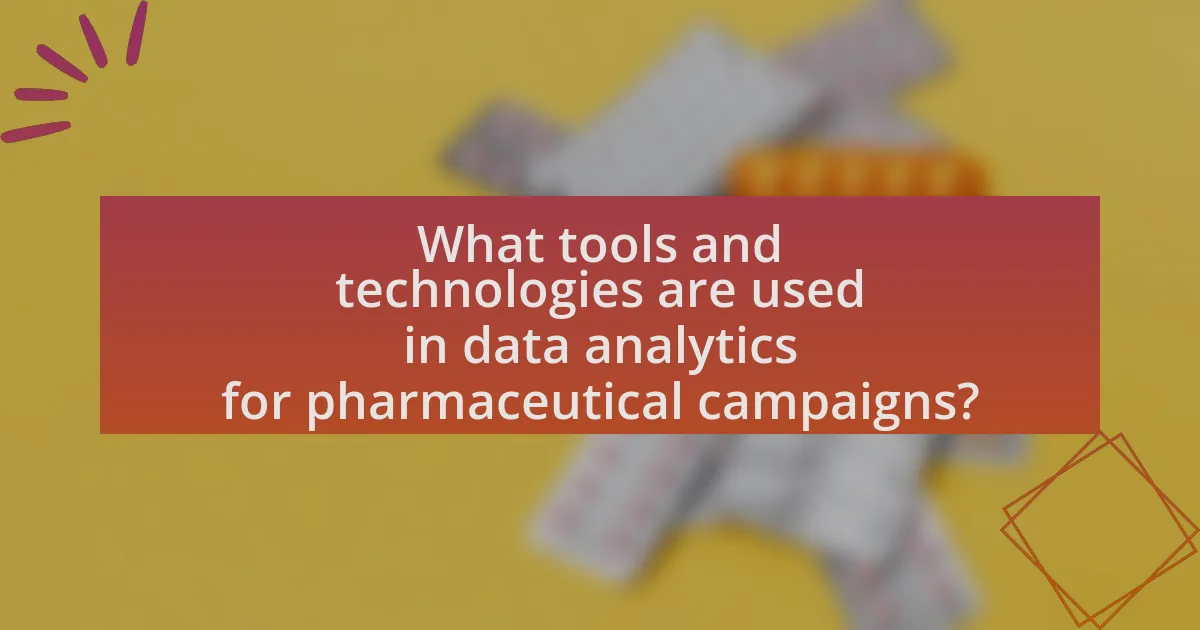
Data analytics for pharmaceutical campaigns utilizes tools and technologies such as SAS, R, Python, Tableau, and SQL. These tools enable data manipulation, statistical analysis, and visualization, which are essential for understanding market trends and patient behaviors. For instance, SAS is widely used for advanced analytics and predictive modeling, while Tableau provides interactive data visualization capabilities that help stakeholders make informed decisions. Additionally, R and Python are popular for their extensive libraries that support data analysis and machine learning, allowing for deeper insights into campaign effectiveness. SQL is crucial for managing and querying large datasets, ensuring that data-driven strategies are based on accurate information.
How do data visualization tools aid in campaign analysis?
Data visualization tools aid in campaign analysis by transforming complex data sets into visual formats that enhance understanding and decision-making. These tools allow marketers to identify trends, patterns, and anomalies in campaign performance metrics, such as engagement rates and conversion statistics. For instance, a study by Tableau found that organizations using data visualization saw a 28% increase in productivity, as visual representations made it easier to interpret data quickly. By presenting data through charts, graphs, and dashboards, these tools facilitate real-time insights, enabling pharmaceutical marketers to adjust strategies promptly based on visual feedback.
What are the most popular data visualization tools in the industry?
The most popular data visualization tools in the industry include Tableau, Power BI, and QlikView. Tableau is widely recognized for its user-friendly interface and powerful analytics capabilities, making it a top choice among data professionals. Power BI, developed by Microsoft, integrates seamlessly with other Microsoft products and offers robust data modeling features. QlikView is known for its associative data model, allowing users to explore data freely without predefined queries. These tools are frequently used in various sectors, including pharmaceuticals, to enhance data-driven decision-making and improve campaign targeting.
How can visualization impact decision-making in campaigns?
Visualization significantly enhances decision-making in campaigns by transforming complex data into easily interpretable graphical formats. This clarity allows stakeholders to quickly identify trends, patterns, and anomalies that inform strategic choices. For instance, a study by Few (2012) highlights that visual representations of data can reduce cognitive load, enabling faster comprehension and more effective communication among team members. Additionally, research from the Journal of Marketing Research indicates that visual data aids in predicting consumer behavior, which is crucial for tailoring pharmaceutical campaigns to specific target audiences. Thus, effective visualization not only streamlines the decision-making process but also improves the overall efficacy of campaign strategies.
What role does machine learning play in pharmaceutical data analytics?
Machine learning plays a critical role in pharmaceutical data analytics by enabling the analysis of vast datasets to identify patterns, predict outcomes, and optimize drug development processes. This technology enhances the ability to process complex biological data, such as genomics and clinical trial results, leading to more informed decision-making. For instance, machine learning algorithms can analyze patient data to predict responses to treatments, thereby improving personalized medicine approaches. Additionally, studies have shown that machine learning can reduce the time and cost associated with drug discovery by streamlining the identification of potential drug candidates and optimizing clinical trial designs.
How can machine learning algorithms predict market trends?
Machine learning algorithms predict market trends by analyzing historical data and identifying patterns that indicate future movements. These algorithms utilize techniques such as regression analysis, time series forecasting, and classification to process vast amounts of data, including sales figures, consumer behavior, and economic indicators. For instance, a study published in the Journal of Business Research demonstrated that machine learning models could achieve up to 90% accuracy in predicting stock market trends by leveraging historical price data and sentiment analysis from social media. This ability to analyze complex datasets allows businesses to make informed decisions and optimize their strategies in real-time.
What are the limitations of using machine learning in this context?
The limitations of using machine learning in the context of leveraging data analytics for targeted pharmaceutical campaigns include data quality issues, interpretability challenges, and regulatory constraints. Data quality issues arise when the datasets used for training models are incomplete, biased, or not representative of the target population, which can lead to inaccurate predictions and ineffective campaigns. Interpretability challenges occur because many machine learning models, particularly deep learning algorithms, operate as “black boxes,” making it difficult for stakeholders to understand how decisions are made, which is crucial in the highly regulated pharmaceutical industry. Regulatory constraints further limit the use of machine learning, as compliance with laws such as HIPAA and FDA guidelines requires transparency and accountability in data handling and model outcomes, potentially hindering the adoption of advanced analytics techniques.
What are the best practices for implementing data analytics in pharmaceutical campaigns?
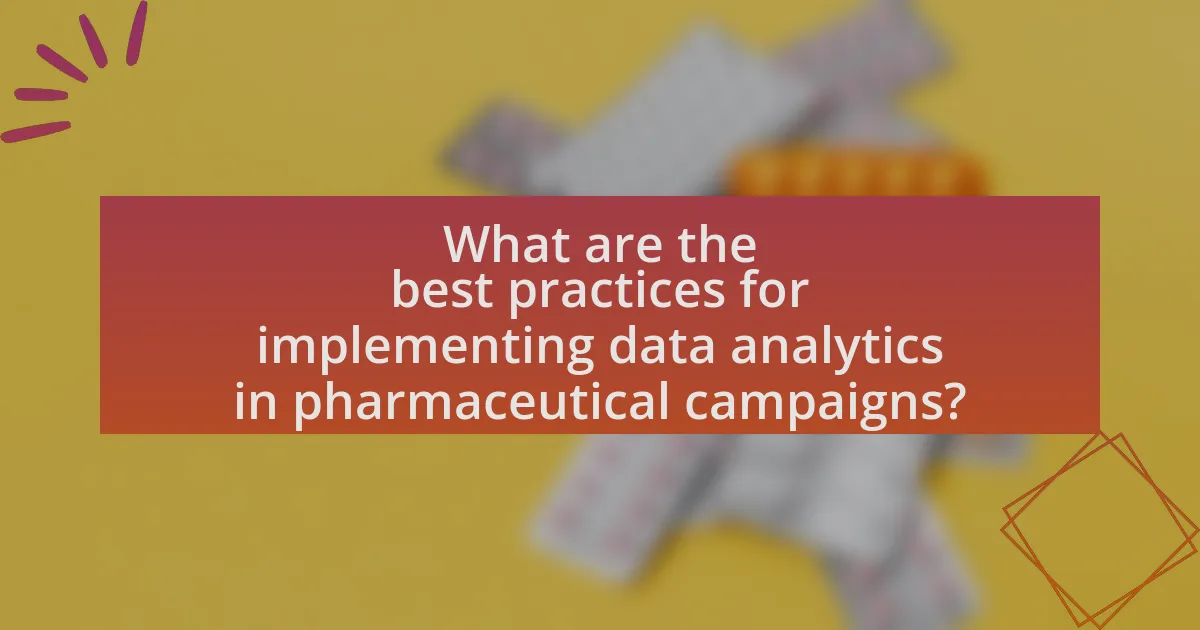
The best practices for implementing data analytics in pharmaceutical campaigns include establishing clear objectives, utilizing robust data sources, ensuring compliance with regulations, and employing advanced analytical techniques. Clear objectives guide the analytics process, allowing teams to focus on specific outcomes, such as improving patient engagement or optimizing marketing strategies. Utilizing robust data sources, including electronic health records and patient databases, enhances the quality and relevance of insights derived from analytics. Compliance with regulations, such as HIPAA, is crucial to protect patient privacy and maintain trust. Advanced analytical techniques, such as predictive modeling and machine learning, enable more accurate forecasting and segmentation of target audiences, leading to more effective campaigns. These practices are supported by industry studies that demonstrate improved campaign performance and ROI when data analytics is effectively integrated.
How can companies ensure data quality and integrity?
Companies can ensure data quality and integrity by implementing robust data governance frameworks and regular data validation processes. A strong data governance framework establishes clear policies, roles, and responsibilities for data management, which helps maintain consistency and accuracy across datasets. Regular data validation processes, such as automated checks and manual audits, identify and rectify errors, ensuring that the data remains reliable for analysis. According to a study by the Data Management Association, organizations with effective data governance practices experience a 30% improvement in data quality, highlighting the importance of these measures in maintaining data integrity.
What steps should be taken to clean and preprocess data?
To clean and preprocess data, the following steps should be taken: first, remove duplicates to ensure each entry is unique, which prevents skewed analysis. Next, handle missing values by either imputing them with statistical methods or removing incomplete records, as this maintains the integrity of the dataset. Following this, standardize data formats, such as date and numerical values, to ensure consistency across the dataset. Additionally, outlier detection should be performed to identify and address anomalies that could distort analysis results. Finally, normalize or scale the data if necessary, particularly for algorithms sensitive to data ranges, ensuring that all features contribute equally to the analysis. These steps are essential for preparing data for effective analysis in targeted pharmaceutical campaigns, as they enhance data quality and reliability.
How can data governance frameworks support analytics efforts?
Data governance frameworks support analytics efforts by ensuring data quality, consistency, and compliance, which are critical for accurate analysis. These frameworks establish policies and procedures that define data ownership, data stewardship, and data lifecycle management, thereby enhancing the reliability of data used in analytics. For instance, organizations that implement robust data governance frameworks experience a 30% improvement in data quality, leading to more effective decision-making and targeted campaigns in the pharmaceutical sector. This structured approach not only mitigates risks associated with data misuse but also fosters a culture of accountability, ultimately driving better analytics outcomes.
What strategies can enhance the effectiveness of targeted campaigns?
Utilizing data analytics to segment audiences effectively enhances the effectiveness of targeted campaigns. By analyzing demographic, behavioral, and psychographic data, pharmaceutical companies can tailor their messaging and outreach strategies to specific groups, increasing engagement rates. For instance, a study by McKinsey & Company found that companies using advanced analytics in their marketing strategies saw a 10-20% increase in campaign effectiveness. Additionally, employing A/B testing allows for real-time adjustments based on audience response, further optimizing campaign performance.
How can A/B testing improve campaign outcomes?
A/B testing can improve campaign outcomes by allowing marketers to compare two versions of a campaign element to determine which performs better. This method provides data-driven insights that help optimize messaging, design, and targeting strategies. For instance, a study by Optimizely found that A/B testing can lead to conversion rate increases of up to 49% when the winning variant is implemented. By systematically testing variations, marketers can make informed decisions that enhance engagement and effectiveness in pharmaceutical campaigns.
What metrics should be tracked to measure campaign success?
To measure campaign success, key metrics include return on investment (ROI), conversion rates, engagement rates, and customer acquisition costs. ROI quantifies the financial return relative to the campaign’s cost, providing a clear indicator of profitability. Conversion rates reflect the percentage of target audience members who take desired actions, such as making a purchase or signing up for a newsletter, indicating the effectiveness of the campaign in driving actions. Engagement rates measure interactions with the campaign content, such as likes, shares, and comments, which help assess audience interest and involvement. Customer acquisition costs calculate the total cost of acquiring a new customer, allowing for evaluation of the efficiency of marketing spend. These metrics collectively provide a comprehensive view of campaign performance and effectiveness in achieving business objectives.
What common challenges do pharmaceutical companies face in leveraging data analytics?
Pharmaceutical companies commonly face challenges such as data integration, data quality, regulatory compliance, and talent shortages when leveraging data analytics. Data integration issues arise from disparate data sources, making it difficult to create a unified view of information. Poor data quality can lead to inaccurate insights, impacting decision-making processes. Regulatory compliance is critical, as companies must navigate stringent laws governing data usage and patient privacy, which can complicate analytics efforts. Additionally, a shortage of skilled data scientists and analysts limits the ability to effectively interpret and utilize data, hindering the overall effectiveness of data-driven strategies in targeted pharmaceutical campaigns.
How can data privacy regulations impact analytics efforts?
Data privacy regulations can significantly restrict analytics efforts by imposing limitations on data collection, storage, and usage. These regulations, such as the General Data Protection Regulation (GDPR) in Europe, require organizations to obtain explicit consent from individuals before processing their personal data, which can reduce the volume of available data for analysis. Furthermore, compliance with these regulations often necessitates the implementation of stringent data governance practices, which can slow down the analytics process and increase operational costs. For instance, a study by the International Association of Privacy Professionals (IAPP) found that 70% of organizations reported that privacy regulations have complicated their data analytics initiatives, highlighting the tangible impact of these laws on the ability to leverage data effectively in targeted campaigns.
What strategies can mitigate risks associated with data analytics?
Implementing robust data governance frameworks is a key strategy to mitigate risks associated with data analytics. These frameworks establish clear policies for data management, ensuring data quality, security, and compliance with regulations such as HIPAA in the pharmaceutical sector. Additionally, employing advanced data encryption techniques protects sensitive information from unauthorized access, while regular audits and assessments identify vulnerabilities in data handling processes. Research indicates that organizations with strong data governance practices experience 30% fewer data breaches, highlighting the effectiveness of these strategies in safeguarding data integrity and privacy.
What are practical tips for optimizing data analytics in pharmaceutical campaigns?
To optimize data analytics in pharmaceutical campaigns, implement a robust data integration strategy that consolidates data from various sources such as clinical trials, market research, and sales data. This integration allows for a comprehensive view of the campaign’s performance and patient engagement. Additionally, utilize advanced analytics techniques, including predictive modeling and machine learning, to identify trends and forecast outcomes, which can enhance decision-making processes.
Moreover, ensure that data quality is prioritized by regularly cleaning and validating datasets to eliminate inaccuracies that could skew results. Employ real-time analytics to monitor campaign performance continuously, enabling quick adjustments based on emerging data insights. Finally, foster collaboration between data scientists and marketing teams to align analytical insights with strategic objectives, ensuring that data-driven decisions effectively target the intended audience.
